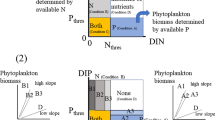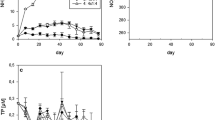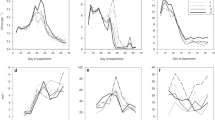Abstract
The dynamics of seston and dissolved elements in a meromictic lake with high concentrations of manganese and iron in the monimolimnion were studied through an annual cycle. This publication presents results for assimilation, sedimentation and recovery of nutrients (C, N, P, and Si) in the trophogenic zone. Phosphorus deficiency kept the productivity of the diatom dominated phytoplankton at an oligotrophic level. High concentrations of iron in influent streams and redistribution followed by precipitation of iron during periods of partial turnover removed phosphorus from the water. High concentrations of manganese and sulfate did not have the anticipated fertilizing effect, and recovery of nutrients from the depth of the lake was negligible. Mass balance calculations indicate that liberation of phosphorus from the sediments in the trophogenic zone was most important for the maintenance of primary production. 75% of carbon, 80% of nitrogen and 25% of phosphorus assimilated by the phytoplankton was mineralized in the trophogenic zone. Silica was effectively regenerated from the littoral zone during the decline of diatom blooms. Nitrogen and silica retention was 45% of the external load compared to 66% for phosphorus.
Similar content being viewed by others
References Adams, M. S. & R. T. Prentki, 1982. Biology, metabolism and functions of littoral submersed weedbeds of Lake Wingra, Wisconsin, USA: A summary and review. Arch. Hydrobiol./Suppl. 62: 333–409.
Ahlgren, I., 1980. A dilution model applied to a system of shallow, eutrophic lakes after diversion of sewage effluents. Arch. Hydrobiol. 89: 17–32.
Andersen, J. M., 1974. Nitrogen and phosphorus budgets and the role of sediments in six shallow Danish lakes. Arch. Hydrobiol. 74: 528–550.
Andersen, J. M., 1975. Influence of pH on release of phosphorus from lake sediments. Arch. Hydrobiol. 76: 411–419.
Behrendt, H., 1990. The chemical composition of phytoplankton and zooplankton in an eutrophic shallow lake. Arch. Hydrobiol. 118: 129–145.
Benner, R., M. A. Moran & R. E. Hodson, 1986. Biogeochemical cycling of lignocellulosic carbon in marine and freshwater ecosystems: Relative contributions of procaryotes and eucaryotes. Limnol. Oceanogr. 31: 89–100.
Bjerve, L. & O. Grøterud, 1980. Discharge measurements by a new-formed relative salt-dilution method in small turbulent streams. Nordic Hydrology 11: 121–132.
Bloesch, J., 1974. Sedimentation und Phosphorhaushalt im Vierwaldstättersee (Horwer Bucht) und im Rotsee. Schweiz. Z. Hydrol. 36: 71–186.
Bloesch, J., P. Stadelmann & H. Bührer, 1977. Primary production, mineralization, and sedimentation in the euphotic zone of two Swiss lakes. Limnol. Oceanogr. 22: 511–526.
Blomqvist, S. & C. Kofoed, 1981. Sediment trapping — a subaquatic in situ experiment. Limnol. Oceanogr. 26: 585–590.
Boström, B., M. Jansson & C. Forsberg, 1982. Phosphorus release from lake sediments. A literature review. Arch. Hydrobiol. Beih. 18: 5–59.
Brabrand, Å., B. A. Faafeng & J. P. M. Nilssen, 1990. Phosphorus supply to phytoplankton production — relative importance of fish excretion versus external loading. Can. J. Fish. aquat. Sci. 47: 364–372.
Cole, J. J., N. F. Caraco & G. E. Likens, 1990. Short-range atmospheric transport: A significant source of phosphorus to an oligotrophic lake. Limnol. Oceanogr. 35: 1230–1237.
Conley, D. J., S. S. Kilham & E. Theriot, 1989. Differences in silica content between marine and freshwater diatoms. Limnol. Oceanogr. 34: 205–213.
Conley, D. J. & C. L. Schelske, 1989. Processes controlling the benthic regeneration and sedimentary accumulation of biogenic silica in Lake Michigan. Arch. Hydrobiol. 116: 23–43.
Culver, D. A., 1977. Biogenic meromixis and stability in a soft-water lake. Limnol. Oceanogr. 22: 667–686.
Currie, D. J. & J. Kalff, 1984. The relative importance of bacterioplankton and phytoplankton in phosphorus uptake in freshwater. Limnol. Oceanogr. 29: 311–321.
Dillon, P. J., R. D. Evans & L. A. Molot, 1990. Retention and resuspension of phosphorus, nitrogen, and iron in a central Ontario Lake. Can. J. Fish. aquat. Sci. 47: 1269–1274.
Einsele, W., 1936. Über die Beziehungen des Eisenkreislaufs zum Phosphatkreislauf im eutrophen See. Arch. Hydrobiol. 29: 664–686. Esteves, F. de A., 1979. Die Bedeutung der aquatischen Makrophyten für den Stoffhaushalt des Schöhsees. II. Die organischen Hauptbestandteile und der Energiegehalt der aquatischen Makrophyten. Arch. Hydrobiol./Suppl. 57: 144–187.
Fleischer, S., 1983. Microbial phosphorus release during enhanced glycolysis. Naturwissenschaften 70: 415.
Fry, B., 1986. Sources of carbon and sulfur nutrition for consumers in three meromictic lakes of New York State. Limnol. Oceanogr. 31: 79–88.
Gächter, R., 1972. Die Bestimmung der Tagesraten der planktischen Primärproduktion — Modelle und In-situ-Messungen. Schweiz. Z. Hydrol. 34: 211–244.
Gächter, R. & A. Bloesch, 1985. Seasonal and vertical variation in the C:P ratio of suspended and settling seston of lakes. Hydrobiologia 128: 193–200.
Gächter, R. &. A. Mares, 1985. Does settling seston release soluble reactive phosphorus in the hypolimnion of lakes? Limnol. Oceanogr. 30: 364–371.
Godshalk, G. L. & R. G. Wetzel, 1978. Decomposition of aquatic angiosperms. II. Particulate components. Aquatic Bot. 5: 301–327.
Golterman, H. L. & R. S. Clymo, 1969. Methods for chemical analysis of fresh waters. Blackwell, 166 pp.
Gommes. R. & H. Muntau, 1981. La composition chimique des limnophites du Lac Majeur. Mem. ist. ital. Idrobiol. 38: 237–307.
Granéli, W., 1978. Sediment oxygen uptake in south Swedish lakes. Oikos 39: 7–16.
Granéli, W., 1979. The influence of Chironomus plumosus larvae on the exchange of dissolved substances between sediment and water. Hydrobiologia 60: 149–159.
Hasler, A. D. & W. G. Einsele, 1948. Fertilization for increasing productivity of natural inland waters. 13th N. Amer. Wild L. Conf. 527–554.
Healey, F. P. & L. L. Hendzel, 1979. Indicators of phosphorus and nitrogen deficiency in five algae in culture. J. Fish. Res. Bd Canada 36: 1364–1369.
Healey, F. P. & L. L. Hendzel, 1980. Physiological indicators of nutrient deficiency in lake phytoplankton. Can. J. Fish. aquat. Sci. 37: 442–453.
Hilton, J., J. P. Lishman & P. V. Allen, 1986. The dominant processes of sediment distribution and focusing in a small, eutrophic, monomictic lake. Limnol. Oceanogr. 31: 125–133.
Hongve, D., 1972. Lake Nordbytjernet, a limnological study with emphasis on macrovegetation and the relationship between hydrography and primary production. Thesis (in Norwegian), University of Oslo, 250 pp.
Hongve, D., 1974. Hydrographical features of Nordbytjernet, a manganese-rich meromictic lake in SE Norway. Arch. Hydrobiol. 74: 227–246.
Hongve, D., 1975. The littoral vegetation of Nordbytjernet, a small lake in south-east Norway. Norw. J. Bot. 22: 83–97.
Hongve, D., 1980. Chemical stratification and stability of meromictic lakes in the Upper Romerike district. Schweiz. Z. Limnol. 42: 171–195.
Hongve, D. & O. K. Skogheim, 1978. Potentiometric titration of sulfate in fresh water. Vatten 34: 183–186.
Jordan, M. J., G. E. Likens & B. J. Peterson, 1985. Organic carbon budget. In Likens, G. E. (ed.). An ecosystem approach to aquatic ecology. Mirror Lake and its Environment. Springer-Verlag, New York: 292–310.
Jørgensen, P. & S. R. Østmo, 1990. Hydrology in the Romerike area, southern Norway. Nor. geol. unders. Bull. 418: 19–26.
Kamp-Nielsen, L., 1974. Mud-water exchange of phosphate and other ions in undisturbed sediment cores and factors affecting the exchange rates. Arch. Hydrobiol. 73: 218–237.
Kamp-Nielsen, L., 1975. A kinetic approach to the aerobic sediment-water exchange of phosphorus in lake Esrom. Ecol. Modelling 1: 153–160. Kjensmo, J., 1967. The development and some main features of ‘iron-meromictic’ soft water lakes. Arch. Hydrobiol./Suppl. 32: 137–312.
Kjensmo, J., 1968. The primary production and its influence on the meromictic stability in Lake Svinsjøen. Schweiz. Z. Hydrol. 30: 297–317.
Klaveness, D., 1977. Morphology, distribution and significance of the manganese-accumulating microorganism Metallogenium in lakes. Hydrobiologia 56: 25–33.
Lee, G. F., W. C. Sonzogni & R. D. Spear, 1977. Significance of oxic vs anoxic conditions for Lake Mendota sediment phosphorus release. In H. L. Golterman (ed.), Interactions between sediments and freshwaters. Dr W. Junk Publishers, The Hague: 294–306.
Lehmann, R., 1983. Untersuchungen zur Sedimentation in einem oligotrophen Alpensee (Königsee) wärend der sommerlichen Schichtung. Arch. Hydrobiol. 96: 486–495.
Likens, G. E. & M. B. Davis, 1975. Post-glacial history of Mirror Lake and its watershed in New Hampshire, USA: an initial report. Verh. int. Ver. Limnol. 19: 982–993.
Løvstad, Ø., 1977. The influence of limiting factors on some usual planktonic diatoms. Thesis (in Norwegian), University of Oslo.
Løvstad, Ø., 1986. Biotests with phytoplankton assemblages. Growth limitation along temporal and spatial gradients. Hydrobiologia 134: 141–149.
Lund, J. W. G., 1950. Studies on Asterionella formosa Hass. II. Nutrient depletion and the spring maximum. J. Ecol. 38: 1–35.
Mortimer, C. H., 1941–42. The exchange of dissolved substances between mud and water in lakes. J. Ecol. 29–30: 280–329, 147–201.
Norwegian National Committee for the International Hydrological Decade, 1975. Hydrological data-Norden. Romerike Representative basin, Norway. Data volume 1972–74. Oslo, 50 pp.
Ohle, W., 1962. Die Stoffhaushalt der Seen als Grundlage einer allgemeinen Stoffwechseldynamik der Gewässer. Kieler Meeresforschungen 18: 107–120.
Overmann, J. & M. M. Tilzer, 1989. Control of primary productivity and the significance of photosynthetic bacteria in a meromictic kettle lake. Mittlerer Buchensee, West-Germany. Aquatic Sci. 51: 261–278.
Parkin, T. B. & T. D. Brock, 1981. Photosynthetic bacterial production and carbon mineralization in a meromictic lake. Arch. Hydrobiol. 91: 366–382.
Rippey, B., 1983. A laboratory study of the silicon release process from a lake sediment (Lough Neagh, Northern Ireland). Arch. Hydrobiol. 96: 417–433.
Rosa, F., 1985. Sedimentation and sediment resuspension in Lake Ontario. J. Great Lakes Res. 11: 13–25.
Ryding, S.-O. & C. Forsberg, 1977. Sediments as a nutrient source in shallow, polluted lakes. In Golterman, H. L. (ed.) Interactions between sediments and freshwater. Dr W. Junk Publishers, The Hague: 227–234.
Ryding, S.-O. & C. Forsberg, 1979. Shortterm load-response relationships in shallow, polluted lakes. In J. Barica & L. R. Mur (eds), Hypertrophic ecosystems. Developments in Hydrobiology 2. Dr W. Junk Publishers, The Hague: 96–103.
Sicko-Goad, L., C. L. Schelske & E. F. Stoermer, 1984. Estimation of intracellular carbon and silica content of diatoms from natural assemblages using morphometric techniques. Limnol. Oceanogr. 29: 1170–1178.
Sommer, U. & H.-H. Stabel, 1983. Silicon consumption and population density changes of dominant planktonic diatoms in Lake Constance. J. Ecol. 71: 119–130.
Søndergaard, M., B. Riemann, L. M. Jensen, N. O. G. Jørgensen, P. K. Bjørnsen, M. Olesen, J. B. Larsen, O. Geertz-Hensen, J. Hansen, K. Christoffersen, A.-M. Jespersen, F. Andersen & S. Bosselmann, 1988. Pelagic food web processes in an oligotrophic lake. Hydrobiologia 164: 271–286. Tessenow, U., 1966. Untersuchungen über den Kieselsäurehaushalt der Binnengewässer. Arch. Hydrobiol./Suppl. 32: 1–136.
Tessenow, U., 1972. Lösungs-, Diffusions- und Sorptionsprozesse in der Oberschicht von Seesedimenten. 1. Ein Langzeitexperiment unter aeroben und anaeroben Bedingungen in Fliessgleichgewicht. Arch. Hydrobiol. Suppl. 38: 353–398.
Tessenow, U., 1975. Lösungs, Diffusions- und Sorptionsprozesse in der Oberschicht von Seesedimenten. V. Die Differenzierung der Profundalsedimente eines oligotrophen Bergsees (Feldsee, Hochschwarzwald) durch Sediment-WasserWechselwirkungen. Arch. Hydrobiol. Suppl. 47: 325–412.
Tezuka, Y., 1989. The C:N:P ratio of phytoplankton determines the relative amounts of dissolved inorganic nitrogen and phosphorus released during aerobic decomposition. Hydrobiologia 173: 55–62.
Twinch, A. J. & R. H. Peters, 1984. Phosphate exchange between littoral sediments and overlying water in an oligotrophic north-temperate lake. Can. J. Fish. aquat. Sci. 41: 1609–1617.
Ulén, B., 1978. Seston and sediment in Lake Norrviken. III. Nutrient release from sediment. Schweiz. Z. Hydrol. 40: 287–305.
Ulén, B., 1978a. Seston and sediment in Lake Norrviken. II. Aerobic decomposition of algae. Schweiz. Z. Hydrol. 40. 104–118.
Viaroli. P. & I. Fumagalli, 1991. Regeneration of dissolved reactive silica during decomposition of recalcitrant plant tissues in temporary shallow-water environments. Verh. int. Ver. Limnol. 24: 2717–2721.
Vollenweider, R. A., 1969. A manual on methods for measuring primary production in aquatic environments. Blackwell, 213 pp.
Wetzel, R. G., 1983. Limnology. Saunders College Publishing, 858 pp.
Wetzel, R. G., 1990. Edgardi Baldi Memorial Lecture. Land-Water interfaces: Metabolic and limnological regulators. Verh. int. Ver. Limnol. 24: 6–24.
Wetzel, R. G., P. H. Rich, M. C. Miller & H. L. Allen, 1972. Metabolism of dissolved and particulate detrital carbon in a temperate hard-water lake. Mem. Ist. ital. Idrobiol. 29 Suppl.: 185–243.
Author information
Authors and Affiliations
Additional information
Dept. of Limnology University of Oslo
Rights and permissions
About this article
Cite this article
Hongve, D. Nutrient metabolism (C, N, P, and Si) in the trophogenic zone of a meromictic lake. Hydrobiologia 277, 17–39 (1994). https://doi.org/10.1007/BF00023983
Received:
Revised:
Accepted:
Issue Date:
DOI: https://doi.org/10.1007/BF00023983




